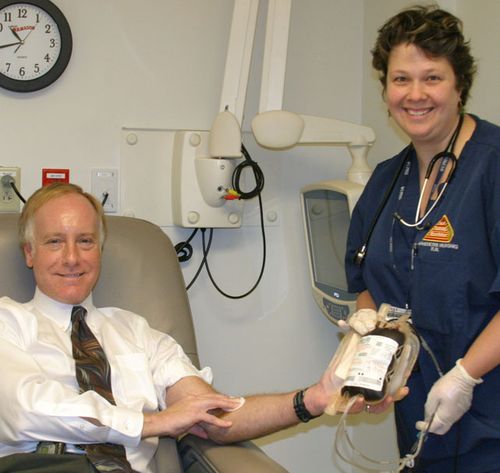 While winter storms, vacation plans, shopping, family and friend gatherings, colds, flu, and other factors can fill a Holiday season, one crucial gift often goes overlooked.
While winter storms, vacation plans, shopping, family and friend gatherings, colds, flu, and other factors can fill a Holiday season, one crucial gift often goes overlooked.
In fact, these factors, among others, demonstrate why donating blood is critical during traditionally low levels this time of year—and why the Blood Donation Center at the Hospital of the University of Pennsylvania (HUP) is invaluable to the hospital’s patients.
“Without ample supplies of blood and blood products, the care we can provide to our patients at HUP would be seriously compromised,” said Don L. Siegel, PhD, MD, professor in the Department of Pathology & Lab Medicine and medical director of the Blood Donation Center. Having our donor center gives us the ability to maintain our own inventory and not be completely reliant on external blood collection facilities that focus on the entire country’s supply.”
Opened in November 2009 and located on the bridge level of Penn Tower at 399 S. 34th street, HUP’s Blood Donation Center encourages donations from the Penn community and members of the general public.
“Patient care and the need for life saving blood products is ongoing,” said Barry Overton, blood donor coordinator at HUP’s Blood Donation Center. “Blood levels are particularly low around the country during winter, but blood is always needed throughout the year.”
HUP transfuses more than 63,000 units of blood and blood products annually, more than any other institution in the region.
The process is simple. After scheduling a whole blood or platelet appointment, donors bring a photo ID to the donation center. After completing a basic health information form and reviewing information about blood donation, a brief health screening checks the donor’s temperature, blood pressure, pulse and hemoglobin levels.
After a staff member cleans the arm and inserts a needle, the donor can relax for a few minutes as blood flows from the patient into a bag until the needle is removed and a bandage is applied.
Snacks, a beverage, and sometimes a small gift await donors when they are finished.
While having some similarities to the whole blood donation process, in platelet donation, or “aphaeresis”, a centrifuge spins the bag of blood product as the donor gives. This spin process separates and collects the platelet cells from the blood and returns the red blood cells and plasma to the donor.
One whole blood donation can help up to two patients, and a donation of platelets can help two to three patients.
Patients at risk of bleeding need these tiny cell fragments to play an integral role in blood clotting. Those needing platelets can include burn and trauma, cardiopulmonary bypass, bone marrow and cancer patients undergoing chemotherapy.
At HUP, platelets can be given more frequently (every 14 days) than whole blood (every 56 days).
As you make plans to spread love and good cheer to your friends and family during this Holiday season, please consider extending that kindness to patients depending on blood and blood products.
The center is open Monday through Fridays from 8:00 am to 3:15 pm. They accept walk-ins whenever possible, but appointments are recommended. To schedule a whole blood donation, please visit www.pennmedicine.org/give-blood. To schedule a platelet donation, or if you have additional questions, please call 215-614-0406. You could make the life-saving difference for a patient in need!
Photo above: Don L. Siegel, PhD, MD, with Jennifer Schwartz, Supervisor of Blood Donation Center